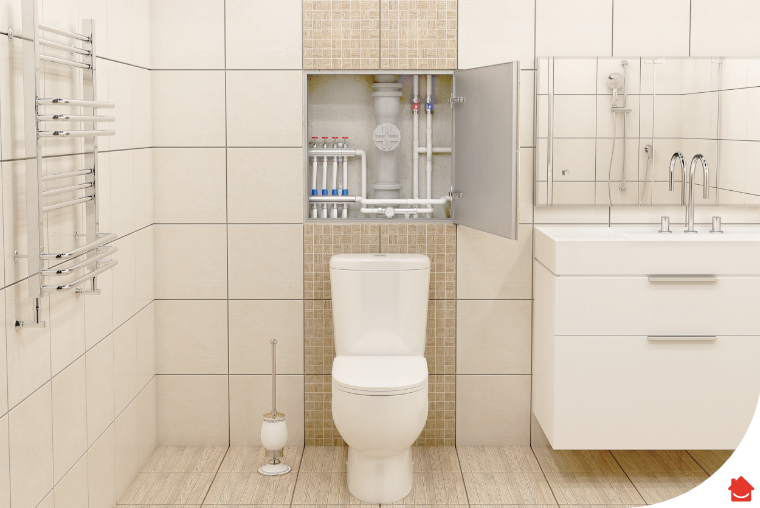We all know that pipes are a necessary feature in any home, but leaving them exposed on a wall can sometimes take away from your overall aesthetic.
Covering a pipe can be a tricky task. It can sometimes lead to more work and the last thing you want is to have a full room renovation on your plate. Thankfully, there are ways around it! To help explain how to cover exposed pipes on your walls, we’ve created a handy list of things you can do to hide or disguise them.
Quick pipe cover fixes
Sometimes covering your ugly pipes can be as simple as a lick of paint! Whether you’ve only got a small area to cover or DIY isn’t your thing – you can achieve your transformation with the help of these four techniques:
1. Paint
This is possibly the most common and beginner-friendly solution to disguising exposed pipes. Painting them in a matching colour to your walls can help blend your unsightly pipework into your decor with minimal effort.
Alternatively, why not paint them in a contrasting shade and make a feature out of them – it’s a smart option for those who love that industrial vibe.
2. Cover them up!
Wrapping your pipes in decorative coverings is a great option for those with small sections to disguise. You can purchase plastic or wooden pipe coverings at most hardware stores to match your decor.
Simply spray some adhesive spray over the pipe and wrap your covering around it. Once you’re done, cut off any excess with a box cutter or a utility knife – make sure to be careful and watch your fingers!
3. A potted plant
Sometimes you need to use what you’ve got to get what you want. A potted plant can work a treat when trying to cover piping.
We suggest finding a houseplant that stands up tall, such as a money tree or an umbrella plant – position it in front of your unsightly pipes and let the plant do the work. If your piping goes all the way up the wall, why not disguise it with hanging plants from your ceiling?
4. Cover with freestanding furniture
If you’re lucky enough to have radiator pipes near your baseboards, using freestanding furniture with thick legs could solve your woes. Place the piece of furniture in front of the wall, but be careful not to lean the item against the pipe, in case it gets too hot.
If you happen to be handy with a saw, you can also make a piece of furniture to fit around your pipes. Just remember to double-check all your measurements before you commit to cutting anything out, so your new creation fits like a glove.
How to cover exposed pipes in the kitchen
Between intricate water piping and awkward cabinet designs, covering pipes in your kitchen can be a tricky challenge. However, there is a range of pipe-disguising methods that can be used to hide those pesky necessities.
Kitchen cupboards are naturally a go-to choice for those with lower-wall piping, while mounting shelving above upper-counter pipes can provide another solution. If you happen to have a large pipe in your kitchen, boxing in the visual eyesore is also a popular choice.
However, evaluating your pipes before boxing them in is a good shout. You never know when you could face a drain blockage that you need easy access to.
How to cover pipes in the bathroom
Like kitchens, there are many methods you can use to spruce up your bathroom piping. From using a pedestal basin to building fake walls – there is an endless range of pipe cover-up ideas. If you’re a homeowner or landlord then lucky you, you have more options to play with.
You can create more permanent solutions to your piping woes by encasing them in the wall or fitting a wall hung toilet. However, this can cause complications in the event of a burst pipe, so make sure to protect yourself against unpleasant drainage issues.
Why not protect yourself against unpleasant drainage issues. On the other hand, renters may need to get more creative. Like we’ve mentioned above, freestanding furniture and house plants are your best friends when covering those unattractive pipes.
How to box pipes on the wall
1. Grab a tape measure and make a note of the height and width of your pipes.
2. Measure how far the pipes stick out from the wall. Remember to measure from the wall out to the front of the pipes and note it down. This measurement will tell you how much wood needs to protrude from the wall. We suggest making sure the markup is precise so that your wood piece fits snugly around the pipes.
3. Using a table or hand saw, cut your three boards to the height of your pipes – make sure you wear gloves and goggles. Depending on how much your pipes stick out, you can use 2 x 4s or even something thinner.
Top tip: Once you’ve cut your first piece of wood, you can use it as a guide for the next ones.
4. Glue the three boards together, making sure to cover each side of the pipes. Use wood glue to stick the boards together so that they form a rectangle with one open side. Clamp them together while they dry to keep the shape. Leave the frame overnight before you get to work on the rest.
5. Connect the boards over your pipes with caulk (not to be confused with chalk) – a flexible filler that can be used to seal gaps around your home. You can pick up caulk from most hardware stores or online. Attach the wooden boards over your pipes so that they’re flush with the ground and ceiling. Push the frame up against the wall to cover the pipes completely; then use the caulk to attach the boards to the wall.
6. Paint the wood and caulk in the same tone as the walls. Alternatively, if you have wooden panels on your walls, you can choose to stain the wood to match the panelling instead.
Can you box in gas pipes?
The good news is, yes you can box in gas pipes! However, if they’re pipes that need to be easily accessible for maintenance or safety reasons, it’s suggested they’re assessed by a Gas Safe Engineer first. The box work would also have to have ventilation on either side. This ensures that any small escapes of gas would be detected.
Can you hide radiator pipes in the wall?
Radiator pipes are the most common example of on-show pipework in most of our homes. Thankfully, there’s a range of ways to hide radiator pipes.
An ever-popular way is by simply boxing them in – however, this can give the appearance of less square space. Radiator covers are also a widely used and economic option. On the other hand, utilising skirting boards to conceal unwanted piping has also been a popular choice for many.
Finally, one of the simplest and cheapest ways to hide pipes is with pipe sleeves. Easily slotting over your copper pipework, they can give a uniformed feel to any space with minimal effort. For the best results, it’s always advisable to choose a pipe sleeve in the same colour as your valves or radiator.
Need a helping hand fixing something?
If you find that something needs repairing in your home when covering your pipes do not fret—we’re here to help. At HomeServe, your home and peace of mind is our priority. Tackle your home problems head-on by booking a one-off repair with HomeServe to experience lasting solutions that keep your home running smoothly.




